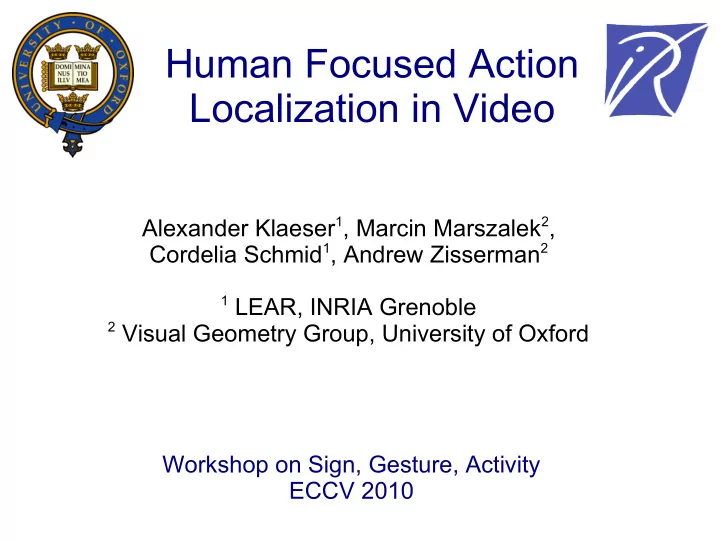

Human Focused Action Localization in Video Alexander Klaeser 1 , Marcin Marszalek 2 , Cordelia Schmid 1 , Andrew Zisserman 2 1 LEAR, INRIA Grenoble 2 Visual Geometry Group, University of Oxford Workshop on Sign, Gesture, Activity ECCV 2010
The problem ● Goal: localization of actions in realistic video ● localization in space (where) ● localization in time (when) ● uncontrolled environment (movies) t_start t_end
The challenge ● Why is it hard ? ● typical problems: intra/inter class variations, background clutter, occlusions, compression, etc. ● movie/video-specific: cropping, camera ego-motion, motion blur, interlacing, shot boundaries
Related work ● Localization by tracking and classification ● No background clutter [Efros ICCV'03, Lu CRV'06] ● Static camera [Hu ICCV'09, Yuan CVPR'09] ● Action localization in space or in time ● Periodic actions [Niebles BMVC'06] ● Temporal alignment [Duchenne ICCV'09] ● Action localization in space-time ● Keyframe priming [Laptev ICCV'07] ● Hypothesis generation [Willems BMVC'09]
Our approach ● Stems from the simple observation that actions are performed by actors ● spatial location is determined by actor's position and does not depend on the type of action ● temporal extent can be found efficiently and more accurately after the spatial location is already known ● We develop a robust actor detector and tracker ● We propose a track-aligned action descriptor ● efficient action localization via sliding window on tracks
Human detection and tracking
Robust human detection ● HOG detector [Dalal05] trained for upper bodies ● 1122 frames from Hollywood2 training movies 1607 annotations jittered to 32k positive samples ● 55k negatives sampled from the same set of frames ● 150k hard negatives ● ● 193 frames from Coffee&Cigarettes training stories additional jittered 6k positives and 9k hard negatives ●
Smoothing and interpolation ● Tracking-by-detection [Everingham09] ● KLT tracker yields feature trajectories ● detections are clustered together (agglomerative clustering) based on connectivity score ● Smoothing + interpolation for continuous tracks can be done very efficiently
Tracks post-processing ● Final classification of tracks to improve precision at high recall ● SVM classifier is learned on 12 different measures characterizing a track – those are min, max and averages (as applicable) of: ● track length (false tracks are often short) ● upper body SVM detection score ● scale and position variability (those often reveal artificial detections) ● occlusion by other tracks (patterns in the background often generate a number of overlapping detections)
Detected human tracks
Action localization in tracks
Why tracks-based descriptor? ● Brings focus to an object of interest ● Background clutter can be reduced ● Geometrically stronger models can be built ● See our technical report for more details ● Adapts to human motion ● Invariant and discriminative at the same time ● Allows efficient action localization ● Human tracks can be reused for multiple actions ● Temporal search is linear in tracks
Action descriptor ● Grid layout of N x N x M cells ● Cells overlap spatially with 50% ● Each temporal slice is aligned to the track (follow movement) ● Each cell 3D HOG histogram ● Icosahedron for orientation quantization (half orientation) ● Layout optimization to 5x5x5 ● Descriptor size: 1250
Action localization ● Sliding window approach ● Exhaustive search over all tracks, track positions and action lengths ● Very efficient in fact, in practice linear in video time ● Further speedup: 2-stage classification ● Linear SVM as first classifier, generate hypotheses via non-maxima suppression ● Re-evaluation of final hypotheses with non-linear SVM (RBF)
Results
Coffee and Cigarettes ● We use the original split by stories [Laptev'07] ● training: 6 stories, 40min, 106 drinking, 90 smoking actions (+”Sea of Love” and “Lab” videos) ● test-drinking: 2 stories, 24min, 38 drinking actions ● test-smoking: 3 stories, 21min 46 smoking actions (originally validation set) ● Average Precision is used for evaluation training test-smoking test-drinking
Do tracks really help? Baselines: 1) Cuboid classifier, full search in video 2) Cuboid classifier, centered on tracks 3) Laptev's baseline, full search
Results for drinking
Results for drinking
Top 9 results for smoking 1 2 3 4 5 6 7 8 9
Hollywood localization ● Dataset based on Hollywood2 data and split ● ~2h of video data in total (~1h training, ~1h test) ● We annotate the spatial and temporal extent of “ phoning ” and “ standing up ” actions ● 153 “phoning” actions (73 training, 80 test) ● 274 “standing up” actions (129 training, 145 test) ● Average Precision is used for evaluation
Top 9 results for standing up 1 2 3 4 5 6 7 8 9
Top 9 results for phoning 1 2 3 4 5 6 7 8 9
Why tracks help ● Classification task is simplified ● the “action world” gets restricted to actors ● Better modeling capability ● descriptor follows actor movements ● Search space is reduced heavily ● less false positives
Complexity ● Exhaustive search ● 5D search (x,y,t position, x/y,t scale) with rigid 3D action representation ● 25min video: 100h processing time per action ● Our approach ● Human detection: 4D search (x,y,t position, x/y scale) with 2D representation ● Action localization: 2D search (t position, t scale) with flexible action representation ● 25min video: 13h per video + 10min per action
Thank you Action detections Human detections Human tracks
Recommend
More recommend